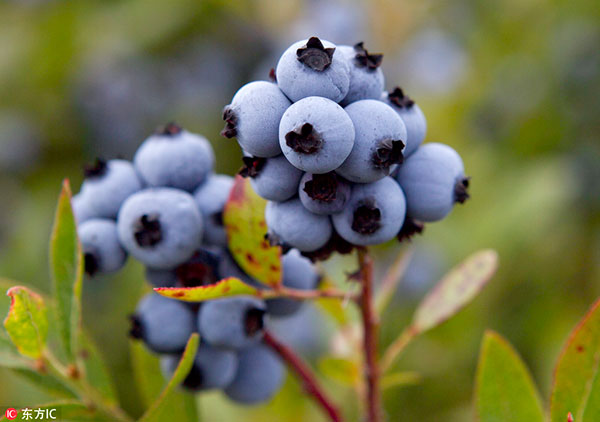 |
|
While cultivated ones can be easily grown at most places, wild blueberries, according to Vatour, could only manage to survive in the glacial soil.[Photo/IC] |
Having been promoting and advertising Canadian wild blueberries for eight years in a row in China, Neri Vautour called this year the best and most exciting time during his latest tour in the country early in November.
And the director executive of Wild Blueberry Association of North America - Canada attributed all this to the help from a little creature: bumblebees.
"By 2014, we weren't really ready for the China market because of the low quantity of wild blueberry harvest. But now, the time is just right for China with our products," as Vatour told China Daily, after a blueberry tasting and briefing event toward retailers and restaurants in Shanghai.
To better supply the increasing demand from Chinese market, as well as other emerging markets, wild blueberries growers in the Atlantic Provinces, westward to Quebec in Canada, have introduced the use of bumblebees few years ago. The buzzing pollinators are believed to extract pollen from blossoms hundreds of times faster than honeybees and able to work much longer hours.
Wild Blueberry Association of North America-Canada now represents four major exporters and 3,500 to 4,000 growers in the Quebec area, which claims to have wild blueberries for more than 10,000 years.
Some argued that the term "wild" is more a marketing word to persuade purchases. But Vatour noted that wild blueberries are different from cultivated ones in that they are natural varieties including more than 100 types with skin colors ranging from pale blue to dark blue appearing on the same vine.
While cultivated ones can be easily grown at most places, wild blueberries, according to Vatour, could only manage to survive in the glacial soil.
"Even if the soil is removed to other places, the wild berries cannot grow," says Vatour.
The character, together with the health benefits believed to result from like antioxidant capacity, has been a major appeal for Chinese consumers, if not people all over the world as well.
"If I have to be honest, I think Chinese consumers, like everyone else, choose flavor first and health second. But we are lucky that we have both," says Vatour.
Up to 65 percent of the wild blueberries consumed around the world are from produced in Canada. Among the over 30 countries Canada exports the fruit, China has yet find a place on the top.
Last year, six million pounds of wild blueberries were exported to China. But Vatour is confident that with the souring demand, it could soon surpass the current top markets like the US and Japan.
With the launch of China-Canada year from 2015 to 2016, there has been a growing amount of agricultural bilateral exchanges between the two countries.
Statistics from Agriculture and Agri-Food Canada (AAFC) showed that bilateral trade between the two countries has increased by 13 percent over the past three years to 39 billion yuan. As of July, China has become the second largest source of agriculture exports and imports of Canada, after the United States, according to China's Ministry of Commerce.
)
|
|
|
|
|
|
|
|
